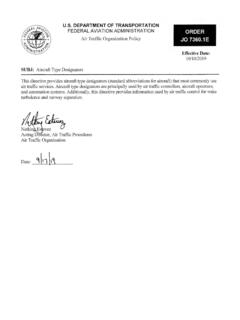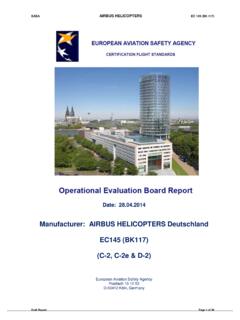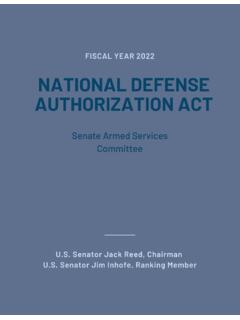Transcription of Unmanned Aircraft Systems
1 FAA Aerospace Forecast Fiscal Years 2021 2041 44 Unmanned Aircraft SystemsUnmanned Aircraft Systems (UAS) have been experiencing healthy growth in the United States and around the world over the past few years. Last year has been no ex-ception despite the profound impact of COVID-19 on the overall economy. A UAS consists of an Unmanned Aircraft and its as-sociated elements including the Aircraft , the control station, and the associated com-munication links that are required for safe and efficient operation in the national air-space system (NAS). While introduction of UAS in the NAS has opened up numerous possibilities, commercial in particular, it has brought operational challenges including safe integration into the NAS. Despite these challenges, the UAS sector holds enormous promise; potential uses include modelers fly-ing for recreational purposes to delivering packages on a commercial basis; including the delivery of medical supplies; and provi-sion of support for search and rescue mis-sions following natural disasters and other public service uses.
2 This section provides a broad overview cov-ering recreational and commercial (or Part 107) Unmanned aircraft13 and their recent trends as gathered from trends in registra-tion, surveys, overall market, and operational information. Using these trends and insights from industry, the FAA has produced a num-ber of forecasts. Forecasts reported in the following sections are driven primarily by the trends in registrations, assumptions of the continuing evolution of the regulatory envi-ronment, the commercial ingenuity of manu-facturers and operators, persistent recrea-tional uses, and underlying demand for UAS services. 13 These are also called, interchangeably, hobby codified at 49 44809 [see non-hobby UAS, respectively. On October 5, , the President signed the FAA Reauthoriza-10169/exception-for-limited- recreational-opera-tion Act of 2018 (Pub.)]
3 L. 115-254). Section 349 of tions-of- Unmanned - Aircraft for more details]. Rec-that Act repealed the Special Rule for model Air-reational fliers, under Section 349, are referred to craft (section 336 of Pub. L. 112-95; Feb. 14, as recreational fliers or modeler community-2012) and replaced it with new conditions to op-based organizations erate recreational sUAS without requirements for [ ]. FAA certification or operating authority. The Ex-In previous notes including other documents of ception for Limited Recreational Operations of the Agency, these terms are often interchanged. Unmanned Aircraft established by section 349 is Trends in Recreational/ model Aircraft and Forecast FAA s online registration system for recrea-tional/ model sUAS went into effect on Dec.
4 21, 2015. This required all UAS weighingmore than pounds (or 250 grams) and fewer than 55 pounds (or 25 kilograms) to be registered using the on-line system( ) or the existing (pa-per-driven) Aircraft registry. Registration was free for the first 30 days, and $5 thereafter. Following a temporary halt in registration due to an order from the US Appeals Court in Washington, in May, 2017 ( , Taylor v. Huerta), the registration requirement for all model Aircraft was reinstated in December, 2017 with the National Defense Authoriza-tion Act (NDAA) [Pub. L. 115-91, Sec. 1092]. NDAA extended the registration for three FAA Aerospace Forecast Fiscal Years 2021 2041 45 years for those registered prior to December, 2017.
5 Registration pace continued after the temporary halt was removed. On October 5, 2018, the President signed the FAA Reau-thorization Act of 2018 that formalized new conditions for recreational use of drones [See for more details]. With the continuing registration, almost million recreational UAS owners had already registered with the FAA by end of November, On average, owner registration stood at around 12,400 per month during January-December, 2020 with some ex-pected peaks during the holiday seasons and For our estimate and projections using the reg-who are active; , those whose registrations istration database, applying to recreational, com-have been canceled or withdrawn are not part of mercial (Part 107) and remote pilots, we use only the data we report in this document.
6 Finally, using those who are registered in the and the ter-the trends for the prior months in 2020 and years ritories. Furthermore, we use those registrants before, we extrapolate it to December, 2020 for completion of annual data. 2015:Q42016:Q32017:Q22018:Q12018:Q42019: Q32020:Q2 Number of Active Registration in the Registrations by Quarters/Year (Cumulative) The current pace of registration has in-creased compared to last year in the same period; average monthly owner registration during 2020 stood 3,000 more than the level observed in 2019. Recreational registration, and thus owner-ship of sUAS, is distributed throughout the country. Using the data available in Decem-ber 2020, a spatial distribution of ownership by zip code below demonstrates that sUAS continue to be distributed throughout thecountry with denser ownership mapping 137,705 1,136,513 02004006008001,0001,200 FAA Aerospace Forecast Fiscal Years 2021 2041 46 closely against the population centers of the country, as expected.
7 At present, recreational ownership registra-the Agency has launched various research tion does not correspond one-to-one with air-activities to understand the possible magni-craft. Unlike their commercial non- model tude of the sector as well as implications on counterparts, the registration rules for recre-likely Aircraft that may be used for recrea-ational operators do not require owners of tional flying and safety implications of the recreational sUAS to register each individual sUAS fleet from gradual integration into the Aircraft ; only operators are registered. For NAS. Finally, the Agency has incorporated each registration, therefore, one or more air-outside analysis to aid forecasting efforts. craft are possibly owned. In some instances, there is no equipment associated with regis-With around recreational operators reg-tration.
8 Free registration at the initial phase istered as of December, 2020, we estimate may have incentivized some to create regis-that there are around million fleet dis-tration without any equipment to report. Not-tinctly identified as recreational Aircraft . withstanding these challenges, there is infor-Comparing with industry sales and other mation available, both from industry and ac-data noted above, we conclude that the num-ademia, allowing us to understand Aircraft ber of recreational Aircraft is almost 30% ownership. Furthermore, under the sponsor-higher than ownership ship of the UAS Integration Research Plan, 15 This calculation involves taking into account re-we expect this rate to change dynamically over tirement, redundancy, and loss of Aircraft corre-time.
9 Assumptions tying ownership to Aircraft sponding to ownership registration. As Aircraft be-holding and issues related to compliance have come sturdier and operators situationally aware, FAA Aerospace Forecast Fiscal Years 2021 2041 47 A comparison of last year s data (2019) with this year s (2020) shows the annual growth rate to be approximately This was pos-sible due to continuation of drones playing dominant roles in recreation that is facilitated by decreasing equipment prices ( , aver-age price around $750 or less), improved technology such as built-in cameras and higher capability sensors, and relatively easy maneuvering. Furthermore, it appears that COVID-19 had a positive impact on recrea-tional registration (see below for more de-tails).
10 Nevertheless, similar to all technolo-gies fueling growth of hobby items ( , cell phone and video game consoles; and prior to that, video cameras and video players), the trend in recreational sUAS has been slowing. It is likely to slow down further as the pace of falling prices diminishes and the early adopters begin to experience limits in their experiments, or recreational eagerness plat-eaus. Given the trend in registration and market de-velopments, we forecast that the recreational sUAS market will saturate at around mil-lion units. However, there is still some upside uncertainty due to further changes in tech-nology including battery, faster integration from a regulatory standpoint, and the likely event of continued decreasing prices. This leads to upside possibilities in the forecast.

















